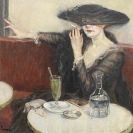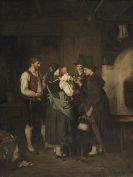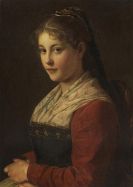
Otto Eckmann
Hamburg
1865 -
Badenweiler
1902
A painter, printmaker, typographer and crafts designer, Otto Eckmann is a leading exponent of German Jugendstil. After commercial training, he studied at the Kunstgewerbeschulen in Hamburg and Nuremberg. Between 1885 and 1890 Otto Eckmann studied painting at the Munich Art Academy.
Although he was quite successful as a painter, Otto Eckmann turned in 1894 to graphic and crafts design, especially for embroidery. Increasingly committed to the new art trend of his day, Otto Eckmann was the first Jugendstil artist to be invited by Grand Duke Ernst Ludwig of Hesse-Darmstadt to be commissioned, even before the artists' colony on Mathildenhöhe was founded (1900), with furnishing and appointing his study in the "Neues Palais on Wilhelminenplatz".
Otto Eckmann did numerous illustrations for the journals "Pan" and "Jugend" from 1895. From 1896 Eckmann was a professor of applied arts at the "Kunstgewerbeschule" in Berlin. Around 1900 Eckmann created Eckmann script. Like Peter Behrens, Otto Eckmann designed a script of his own, which matched the Jugendstil ideal of form. Influenced by neither antiqua nor Fraktur, it is what is known as a bastard script, freely constructed by the script designer, which would exert enormous influence on developments in typography.
Otto Eckmann also designed advertizing materials for industry. Like Peter Behrens, Otto Eckmann worked for AEG (Allgemeine Elektrizitäts-Gesellschaft). He also designed books, covers, vignettes, initials and so on for numerous publishing houses, including S. Fischer, Bruns, Cotta, Diederichs, A. Koch, Reimer, and E.A. Seemann. Otto Eckmann also designed tiles for the ceramics firm Villeroy & Boch.
Would you like to sell a work by Otto Eckmann?
Infos for seller




